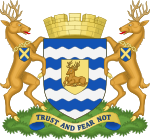Hertfordshire County Council is the upper-tier local authority for the non-metropolitan county of Hertfordshire, in England. The council was created in 1889. It is responsible for a wide range of public services in the county, including social care, transport, education, and the Hertfordshire Fire and Rescue Service. The Conservatives have held a majority of the seats on the council since 1999. The council is based at County Hall in Hertford.
Hertfordshire County Council | |
|---|---|
 | |
 | |
| Type | |
| Type | |
| Leadership | |
Chief Executive (interim) | Scott Crudgington since 1 April 2024[4] |
| Structure | |
| Seats | 78 councillors |
 | |
Political groups |
|
Joint committees | East of England Local Government Association |
Length of term | 4 years |
| Elections | |
| First past the post | |
Last election | 6 May 2021 |
Next election | 1 May 2025 |
| Meeting place | |
 | |
| County Hall, Pegs Lane, Hertford, SG13 8DQ | |
| Website | |
| www | |
History
editElected county councils were created under the Local Government Act 1888, taking over many administrative functions that had previously been performed by unelected magistrates at the quarter sessions.
The first elections were held in January 1889, and the council formally came into being on 1 April 1889, on which day it held its first meeting at Shire Hall, Hertford, the courthouse (built 1771) which had served as the meeting place of the quarter sessions which preceded the county council.[5] The first chairman of the council was Francis Cowper, 7th Earl Cowper, who was also a Liberal member of the House of Lords.[6]
Local government across England and Wales was reformed in 1974 under the Local Government Act 1972, establishing a system of upper-tier county councils and lower-tier district councils. The 1972 Act classed Hertfordshire as a non-metropolitan county, which determined the division of responsibilities between the county council and the ten district councils which were created in Hertfordshire.[7]
Governance
editThe council provides county-level services. District-level services are provided by the county's ten district councils. Much of the county is also covered by civil parishes, which form a third tier of local government for their areas.[8]
Political control
editThe council has been under Conservative majority control since 1999.
Political control of the county council since 1974 has been as follows:[9]
| Party in control | Years | |
|---|---|---|
| No overall control | 1974–1977 | |
| Conservative | 1977–1985 | |
| No overall control | 1985–1989 | |
| Conservative | 1989–1993 | |
| No overall control | 1993–1999 | |
| Conservative | 1999–present | |
Leadership
editThe leaders of the council since 1995 have been:[10]
| Councillor | Party | From | To | |
|---|---|---|---|---|
| John Metcalf | Labour | 1995 | Jun 1999 | |
| Robert Ellis | Conservative | 15 Jun 1999 | 21 Mar 2006 | |
| David Beatty | Conservative | 28 Mar 2006 | 26 Sep 2007 | |
| Robert Gordon | Conservative | 9 Oct 2007 | 6 Oct 2017 | |
| David Williams | Conservative | 21 Nov 2017 | 9 May 2021 | |
| Richard Roberts | Conservative | 25 May 2021 | ||
Composition
editAfter the 2021 election and by-elections up to December 2023, the composition of the council was:[11]
| Party | Councillors | |
|---|---|---|
| Conservative | 45 | |
| Liberal Democrats | 24 | |
| Labour | 7 | |
| Green | 1 | |
| Independent | 1 | |
| Total: | 78 | |
The independent and Green councillors sit together as a group.[12] The next election is due in 2025.
Premises
editThe council is based at County Hall on Pegs Lane in Hertford, lying to the south-west of the town centre. The building was completed in 1939; there was no opening ceremony due to the outbreak of the Second World War.[13]
Elections
editElections are held every four years, interspersed by three years of elections to the ten district councils in the county. Since the last boundary changes in 2017, there have been 78 electoral divisions electing one councillor each.[14]
References
edit- ^ Day, Christopher (2 June 2023). "Herts County Council: New chairman and changes to cabinet". The Comet. Retrieved 2 June 2023.
- ^ Price, Deborah (22 May 2024). "Hemel councillor re-elected as Herts County Council chairman after 'great year' in charge". Hemel Today. Retrieved 23 May 2024.
- ^ Corr, Sinead (25 May 2021). "New leader of Herts County Council sets out four-year agenda". Bishop's Stortford Independent. Retrieved 1 July 2021.
- ^ Corr, Sinead (16 February 2024). "Herts County Council: Search begins for new chief executive after Owen Mapley quits". Bishop's Stortford Independent. Retrieved 11 May 2024.
- ^ Historic England. "Shire Hall, 15 Fore Street (Grade I) (1268930)". National Heritage List for England. Retrieved 27 March 2024.
- ^ "Hertfordshire County Council". Hertfordshire Mercury. Hertford. 6 April 1889. p. 3. Retrieved 11 May 2023.
- ^ "Local Government Act 1972", legislation.gov.uk, The National Archives, 1972 c. 65, retrieved 11 May 2023
- ^ "Election Maps". Ordnance Survey. Retrieved 27 March 2024.
- ^ "Compositions calculator". The Elections Centre. Retrieved 3 March 2023.
- ^ "Council minutes". Hertfordshire County Council. Retrieved 1 June 2022.
- ^ "Hertfordshire County Council". BBC News. Retrieved 1 July 2021.
- ^ "Hertfordshire's County Councillors by political grouping". Hertfordshire County Council. Retrieved 15 December 2023.
- ^ Historic England. "County Hall Including Terraces and Fountain, Hertford (1268807)". National Heritage List for England. Retrieved 13 August 2019.
- ^ "The Hertfordshire (Electoral Changes) Order 2015", legislation.gov.uk, The National Archives, SI 2015/1873, retrieved 11 May 2023